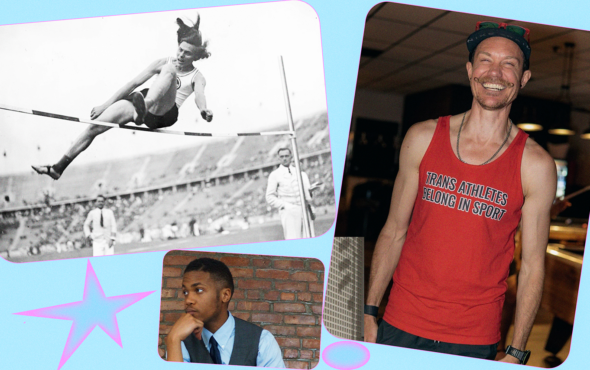
“Outside of medical experts, it’s hard to think of someone who knows more about the human body than a trans person,” says Lara Americo, personal trainer and owner of Ghost Gym. “I feel like trans folks are often very, very skilled at analyzing their bodies, which can be a double-edged sword. When it comes to weightlifting and fitness, it can be a huge strength — if we can move through it without being discriminated against, unsafe, or debilitated by dysphoria.”
On one hand, weightlifting, or strength training, can yield gender-affirming benefits for trans people in ways that make it easier and more empowering to be in one’s body. On the other hand, Ilya Parker, Owner of Decolonizing Fitness knows that the gym can also be a source of distress or even harm for many trans folks. The safest, most empowering path lies somewhere in a delicate balance of aesthetic goals, gym accessibility, and medical needs.
What does strength training have to offer trans people?
Trans people are no strangers to thinking about their bodies and trying to feel better in them. Strength training can offer folks a sense of agency and autonomy.
For example, DJ Rock, personal trainer and fitness instructor at Outbox, a trans-owned boxing and strength gym, shared, “I can’t control that my health care provider has given me a hard time about getting hormones. I can’t control the wait time for affirming surgery. But I can just stretch and lift a heavyweight, right? I can control the number of reps I’m doing today.”
“For example, some folks will not be able to or want to undergo hormone replacement therapy—but you can still modify your physique through intentional movement. You can still build muscle and strength through consistent training using progressive overload principles, adequate nutrition, and proper rest and recovery,” says Parker, regarding the potential benefits of strength training and overall fitness practices.
Though every body’s needs are different, some trans femmes might want to emphasize “titty-lifting” exercises or squats to achieve a more feminized shape, while some trans masc folks often want to build up their chests, shoulders, and arms, for a masculinized shape. Despite many tips and trends that exist within the trans weightlifting world, experts stress nutrition, compassionate self-talk, and trainer-informed routines before venturing into spot-training.

What are some barriers trans weightlifters face?
Aside from the obvious spread of right-wing legislation in the US targeting trans people in sports, fitness as an industry and practice, creates many barriers to entry for trans people. From gendered locker rooms, to the toxicity of weight-lifting culture, to the bioessentialism of many competitive sports — there’s no shortage of ways gyms and fitness institutions exclude trans people, intentionally or not.
“So many of us face employment discrimination,” Rock says. “Transitioning is expensive, saving for surgery, recovering from surgery, buying binders and tucking panties, and all of that kind of stuff adds up.”
“I always call on fitness and wellness spaces to consider—if you have equity in your mission, if you want more trans people in your gym and you charge $300 a day for a membership, it’s just not going to happen. And so, how do we increase access to some of the folks who are most deserving of these moments of wellness, and safety, and care?”
What are some medical concerns trans people might face in strength training?
Of course, trans people sustaining a joyful relationship with any kind of fitness is often beholden to their medical needs and where they may be in their transition.
Though not all trans people medically transition, those who do often have specific and ever-changing medical needs. “One of the biggest issues that I consistently see through my practice is from scar tissue and its effect on tissue mobility,” says Taylor Hatcher, sports medicine massage therapist and coach at Living Wellness Center. “I think it’s important to have an active flexibility and mobility routine. For your chest, your lats, your triceps, your biceps, your neck muscles, your spine.” This is just one way gender-affirming care could affect your fitness or movement needs.
“For folks who don’t have access to adequate gender-affirming medical care, modifying the body to align with one’s gender truth through movement and food can also be life-sustaining,” says Parker. However, he adds that it’s also a layered connection because this can easily lead to a disordered relationship with food and exercise.
Trans people experience higher rates of eating disorders and exercise addiction more than any other group of people; current research indicates that trans folks have a two to four times higher rate of eating disorders than the white, 20-something cisgender women who were previously believed to have the highest rate of EDs. “It is important to recognize that eating disorders and exercise addiction are serious, life-threatening mental illnesses that require compassionate, knowledgeable, care that is rooted in harm reduction,” Parker adds.
Hormone replacement therapy can also affect how one experiences the gym altogether as well. Trans masculine individuals can experience rapid muscle growth and increased strength (in addition to increased risk for injury), while trans femmes can face a loss of motivation to go to the gym or slowed increase in muscle mass. Navigating this usually requires a trusted doctor’s advice, and ideally some kind of community resource or community to gain the same solidarity cis people are so easily afforded.
For folks who don't have access to adequate gender-affirming medical care, modifying the body to align with one's gender truth through movement and food can also be life-sustaining.
Finding your workout space and routine
Americo stresses that one of the most important ingredients in a beneficial strength training journey is consistency and selecting a place to work out that sets your routine up for success.
Factors of safety and comfort are also vital to your peace of mind, progress, and ability to work out consistently. Landyn Pan is an online strength and nutrition coach, mostly for trans folks, because he values the holistic nature of remote training. Some of his clients are in less accepting areas like Wyoming or Kansas, and would rather work out at home.
“In my online program, we do weekly group calls that are optional. We’ll have discussions on different topics like form, nutrition, or mind-muscle connection. We’ll talk about macros. And we also have conversations that are just about like, ‘How do we navigate relationships with our bodies through fitness as trans people?’” says Pan.
Americo mentioned that trans people searching for the right space for them should (discerningly) search for relevant trans fitness forums, pages, and clubs or see if your local gyms have things like LGBTQ+ takeover nights, queer owners or instructors, or more inclusive approaches to locker rooms.
But the thing Pan stressed the most was to never compare yourself to others, an age-old sentiment with renewed importance in our community.
“So much of our community finds each other online,” says Ashton Hazen, certified personal trainer and nursing student, “that can lead us to seeing others in two dimensional photos and videos and we can forget that we are three dimensional beings with bodies.”
“Through weightlifting, I’ve been able to feel more grounded in myself.” Hazen says. When developing your routine, he says, think less about the lofty aesthetic goals you’ve created based on someone else’s body, and instead focus on when and how it feels good.
Weightlifting shouldn’t be so much about meeting a mark on your own appearance, or editing and erasing things you don’t like. Real weight training means finding confidence in the totality of your body and learning how to love yourself even in transitional periods.
“I feel like so often being trans, you’re constantly having an out-of-body experience,” Hazen says. “Just try to get yourself back inside of your body, and be okay with the femininity and masculinity, and androgynous expressions that come out.”

